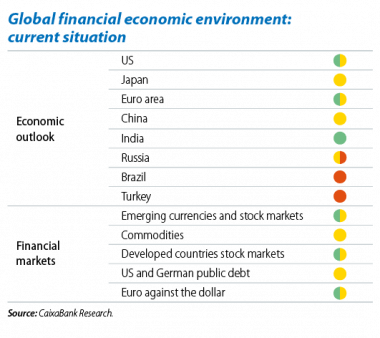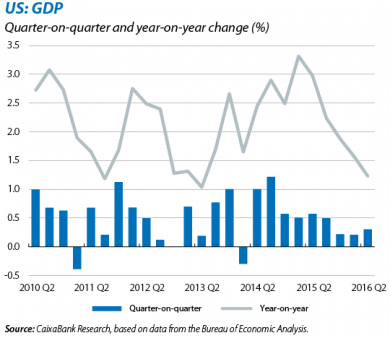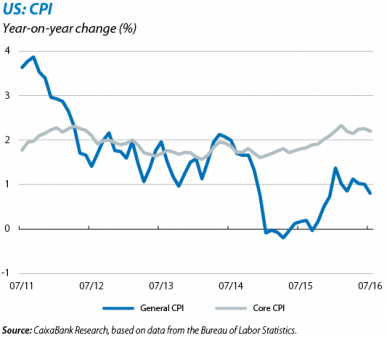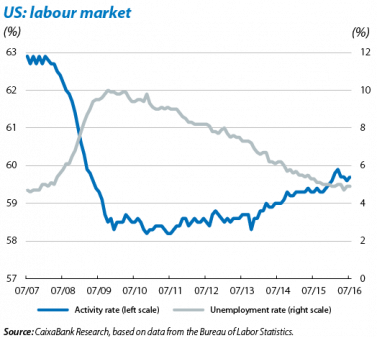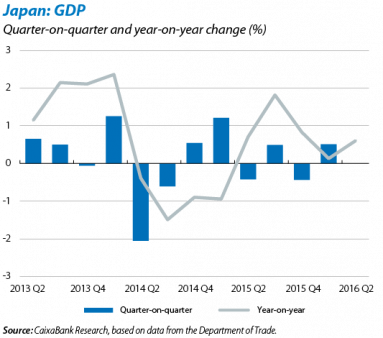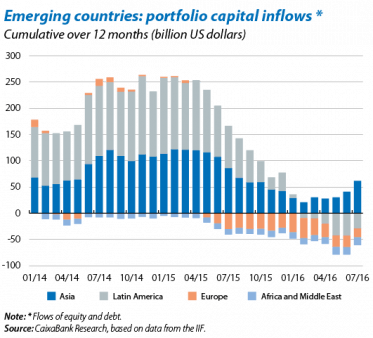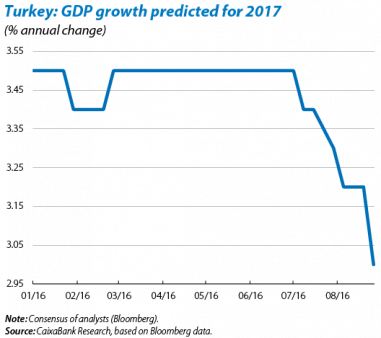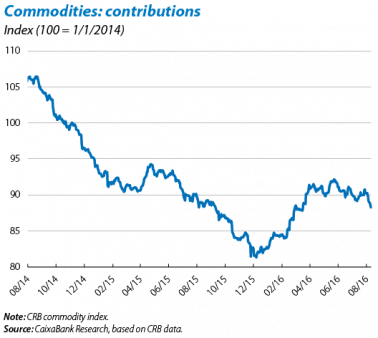The expansion continues but downside risks remain
After a calm summer the world economy continues its moderate upward trend. The latest indicators tend to confirm that the world economy is en route to growing by 3.2% in 2016. This is a moderate rate of acceleration compared with 2015 when GDP growth was 3.1%, occurring within a context of notable geopolitical uncertainty and risks that growth will finally be somewhat less than predicted. Nonetheless the fact that the Federal Reserve (Fed) is implying, a little more decisively, that it will return to monetary normalisation this year and the confirmation that, to date, the negative impact of Brexit seems to be essentially limited to the British economy, have helped some investor concerns to diminish. Also positive is the fact that the emerging economies are once again looking dynamic after a worrying 2015 (although there is still concern in cases such as Brazil’s).
UNITED STATES
The US economy is going through the mature stage of its cycle. The slight downward revision of the historical series of GDP figures carried out in July and especially the disappointing growth figures for 2016 Q2 have led some media and analysts to doubt the actual point in the cycle reached by the US economy and even whether the Fed should delay its interest rate hike for longer. In our opinion the diagnosis is clear: the country’s macroeconomic conditions more than justify continuing the process of monetary normalisation started last December. This opinion is based essentially on three elements: the temporary nature of the slowdown in Q2, the upward outlook for inflation and the consolidation of the labour market.
Temporary slowdown in Q2. The US economy advanced by 0.3% quarter-on-quarter in 2016 Q2 (1.2% year-on-year), a lower figure than predicted and only marginally higher than the weak Q1 when GDP grew by just 0.2%. This disappointing GDP growth was largely due to the sizeable negative contribution made by the accumulation of stock, deducting 0.3 pps, when the reduction had been just 0.1 pps in the four preceding quarters. This factor alone suggests there will probably be an upswing in activity in the coming quarters. Also very positive is the trend in private consumption which grew by 1.1% quarter-on-quarter, a rate that has not been recorded since 2014 Q4. The dynamism of consumption comes from a resistant base that will help growth to speed up in the second half of 2016. The trend in investment raises more doubts, however. Its sharp decline (–2.5%) has been mainly due to the bad performance by residential investment, halting its recovery since the beginning of 2014. Apart from the GDP figures for Q2, available indicators for Q3 point to the emergence of a scenario of acceleration. In particular, in July business sentiment indices (ISM), both for manufacturing and services, stood above the 50-point threshold that denotes expansion in the rate of activity.
Inflation, on the point of rising. In July the CPI grew by 0.8% year-on-year, 0.2 pps less than the previous month, due to a drop in the energy component, while core inflation stood at 2.2% (2.1% in June). This tone of contained inflation is about to change because, as from August, the base effect of oil will start to disappear. According to CaixaBank Research forecasts, by December 2016 the general index will be around 1.9% year-on-year, going above 2.5% in the first part of 2017.
A solid labour market, another symptom of the mature stage of the cycle. The trend in the labour market, to which the Fed pays great attention, is consistent with an economy going through a mature phase in the cycle. 255,000 jobs were created in July, above the bar of 200,000, while unemployment remained at a low 4.9% and wages continued to rise significantly (2.6% year-on-year), representing an added factor of inflationary pressure.
The Fed’s second hike is approaching. Given this domestic macroeconomic context, and with a relatively stable international environment, according to CaixaBank Research forecasts the Fed is very likely to raise its benchmark rate by the end of the year, a move which will open the door to a more continual, albeit gradual process of interest rate hikes in 2017 and 2018 (75 bps in each of these years).
JAPAN
A slip-up in Q2. In 2016 Q2 GDP grew by 0.05% quarter-on-quarter (0.6% year-on-year) compared with 0.5% in Q1 due to the lethargy shown by private consumption and weak exports to the US and China. This poor tone in household spending can also be seen in inflation. In July the general index fell by 0.5% year-on-year, worse than the already weak figure posted in June (–0.3% year-on-year). Core inflation did not escape this inflationary lethargy either, with a minimal rate of growth in July, namely 0.3% year-on-year, half the average recorded in the first half of 2016. Given this situation there is speculation that, after the new fiscal stimulus approved in July, the BoJ might expand its rate of quantitative easing in September. Nonetheless there are many doubts regarding the effectiveness of further monetary expansion measures (see the Focus «Japan: monetary policy under scrutiny» in this Monthly Report).
EMERGING ECONOMIES AND COMMODITIES
A better tone in the emerging economies though sources of uncertainty still remain. The latest macroeconomic figures have tended to be positive, reinforcing the view that the emerging Asian economies are still in good shape and that, except for Brazil, Latin America is stabilising. In response to this flow of more constructive indicators, and within a global financial context of investors clearly searching for yield, the financial capital inflows aimed at emerging economies have tended to pick up over the last few months.
Asia: the Chinese and Indian economies remain firm in Q2. The Chinese economy grew by 6.7% year-on-year in Q2 with no change in its rate of growth compared with Q1, while India’s GDP rose by 7.1%, significant growth in spite of being below the figure of 7.9% posted the previous quarter. In the case of China, the data from its national accounts system, together with the latest indicators announced, point to the economy slowing down at a gentle rate at the same time as progress is being made in the complex transformation of its production model (in which consumption and services will play a more important role instead of the traditional two-way model of exports-investment and industry). In the case of India, its notable rate of growth is still apparent, mainly due to domestic factors (in particular to dynamic consumption). One immediate challenge for India will be to ensure the change in management of its central bank does not impinge on the institution’s high credibility.
Brazil, Mexico, Turkey and Russia, four countries facing different emerging dilemmas. In Brazil, confirmation of President Rousseff’s impeachment, already relieved from her position, and doubts regarding the government’s ability to implement the necessary public adjustment, have kept its political situation as a source of uncertainty. As a result, the country’s exit of its recession is still complicated, as shown by the 0.6% drop in GDP in Q2 (–0.4% in Q1). Mexico’s national accounts system GDP figure was not positive either, surprising analysts by posting –0.2% quarter-on-quarter in Q2 (+0.5% in Q1). Nonetheless this should be seen as a temporary glitch, reflecting the Mexican economy’s twofold dependence (on the US and on oil). Turkey’s economy has also become a cause for concern due to uncertainty regarding future institutional developments in the country after the attempted coup in July, as well as other important geopolitical pressures. Lastly, in Russia the 0.6% year-on-year decline in GDP for Q2 was slightly less than expected, suggesting the country is gradually moving away from the severe phase of its recession, although the underlying sensation is still one of a fragile recovery.
Commodities: a halt in the upswing in prices. During the summer, commodity prices tended to consolidate their rally of the previous months. This overall development includes the upward trend in base metals (see the Focus «Base metal prices: a flimsy recovery» in this Monthly Report), the downward trend for many agricultural commodities and the more lateral movement of energy commodities. In particular this last group stands out for the ups and downs recorded in oil. A barrel of Brent quality crude oil stood at 50 dollars on 30 June, fell to 43 dollars at the beginning of August (fundamentally due to an observed increase in supply) then almost returned to its starting point by the end of August (when speculation increased regarding a possible OPEC agreement to adjust supply in the autumn).
